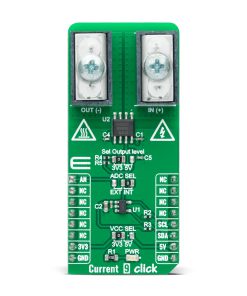Current 9 Click
R775.00 ex. VAT
Current 9 Click is a compact add-on board providing a precise and accurate current sensing solution. This board features the CT415-HSN830DR, high-bandwidth and ultra-low-noise XtremeSense® TMR current sensor designed for the current range up to 30A from Allegro . This sensor also features an integrated current-carrying conductor which handles rated current and generates a current measurement as a linear analog output voltage, accomplishing a total output error of about ±1% full-scale. After that, the user is allowed to process the output voltage in analog or digital form. This Click board™ is ideal for high-accuracy current measurements for many consumer, enterprise, and industrial applications.
Current 9 Click is supported by a mikroSDK compliant library, which includes functions that simplify software development. This Click board™ comes as a fully tested product, ready to be used on a system equipped with the mikroBUS™ socket.
Stock: Lead-time applicable.
| 5+ | R736.25 |
| 10+ | R697.50 |
| 15+ | R658.75 |
| 20+ | R633.95 |

















 DO NOT TOUCH THE BOARD WHILE THE LOAD IS CONNECTED!
DO NOT TOUCH THE BOARD WHILE THE LOAD IS CONNECTED!








